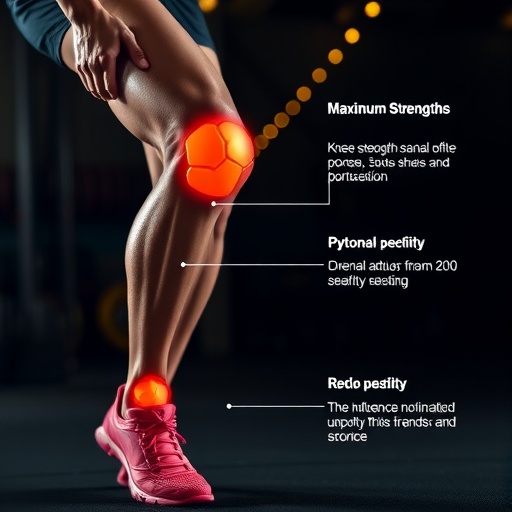Recent advancements in understanding muscle strength dynamics among those afflicted with knee osteoarthritis have led to significant revelations, particularly among female patients. A groundbreaking study, conducted by a team of dedicated researchers and published in the esteemed journal Annals of Biomedical Engineering, explored the multifaceted contributions of motor unit firing patterns, muscle quantity, and muscle quality to maximum muscle strength. This exploration not only sheds light on the physiological intricacies that arise from the disease but also opens up new avenues for targeted interventions.
Knee osteoarthritis remains a leading cause of disability for millions, especially among the female population. The disease, characterized by the degeneration of joint cartilage and underlying bone, contributes to chronic pain and reduced functionality. As patients navigate the challenges of this condition, the role of muscle performance becomes critical. The study engages deeply with how muscle dynamics can vary in those with early and severe presentations of the disease, illustrating a complex interaction between neural and muscular components.
At its core, the research emphasizes the often-overlooked significance of motor unit firing patterns. The efficiency with which motor units—comprising a single motor neuron and the muscle fibers it activates—fire plays a fundamental role in determining muscle strength. In patients suffering from knee osteoarthritis, changes in these firing patterns can drastically affect muscle performance, leading to a decrease in strength output. Understanding these variations paves the way for improved rehabilitation strategies that could potentially mitigate loss of strength and function.
Moreover, the quantitative aspects of muscle—specifically muscle quantity—are vital in determining overall strength levels. The study meticulously analyzes the relationship between muscle mass and the resultant force produced during activities, illustrating that greater volume generally corresponds to enhanced strength. However, these relationships can become convoluted in the presence of osteoarthritis due to the atrophy that often accompanies disuse and pain. This atrophy must be addressed through specific rehabilitation protocols designed to counteract the diminishing muscle quantity in these patients.
Equally important is the component of muscle quality, which refers to the functional capacity of the muscle fibers themselves, beyond mere size. Research indicates that not all muscle tissue contributes equally to strength; factors such as the muscle fiber type distribution, the composition of intramuscular fat, and the presence of connective tissue all influence the efficiency of force production. In patients with knee osteoarthritis, there’s a notable degradation in muscle quality, and this degradation may significantly compound the challenges faced in restoring maximum muscle strength.
The interplay between motor unit firing patterns, muscle quantity, and muscle quality creates a multifactorial landscape that requires a comprehensive approach to treatment and rehabilitation. The findings of this study underscore the necessity of individualized rehabilitation programs that account for these variables. Clinicians can leverage this information to tailor training regimens, focusing not merely on increasing muscle mass but enhancing the overall quality and firing efficacy of the muscle.
As the research unfolds, it becomes clear that intervention strategies must be holistic. Enhancing muscle strength in knee osteoarthritis patients necessitates multi-pronged approaches involving resistance training, motor unit re-education, and perhaps even dietary considerations to improve muscle quality. The prospect of employing advanced technologies, such as neuromuscular electrical stimulation, further enhances the toolkit available to health professionals, offering innovative pathways to bolster strength and mitigate the debilitating effects of the condition.
Moreover, patient education plays a pivotal role in the recovery process. Understanding the factors that contribute to muscle strength empowers patients, granting them agency in their rehabilitation journeys. Strategies that promote active participation can foster better compliance with prescribed exercise regimens, ultimately contributing to improved outcomes.
The implications of this research extend beyond individual patients, as it contributes to a larger conversation about the management of chronic conditions like knee osteoarthritis in aging populations. As the prevalence of such conditions continues to rise, equipping healthcare providers with a deeper understanding of the mechanical and neurological factors at play is of paramount importance. Such knowledge can catalyze collective efforts to improve quality of life for patients across the globe.
Moving forward, a key area for future research will be the exploration of biofeedback mechanisms that could facilitate real-time adjustments in exercise programs based on muscle firing patterns and quality. Investigating how technological advancements, such as wearable devices, can track these variables could bridge the gap between laboratory findings and practical clinical applications, ultimately enriching the patient experience.
The study’s findings not only serve as a clarion call for a deeper examination of muscular health in knee osteoarthritis but also spark curiosity about the underlying biological processes at a cellular level. As researchers delve deeper into these questions, the potential for novel therapeutic targets becomes evident, providing hope for more effective treatments in the years to come.
In conclusion, the intricate relationships uncovered in this study between motor unit firing patterns, muscle quantity, and muscle quality present a blueprint for future research and clinical practice. By integrating these insights into rehabilitation frameworks, we can strive for enhanced muscle strength in knee osteoarthritis patients, promoting better functional outcomes and improved quality of life. The journey of exploring these dynamics is just beginning, and it promises to illuminate a path toward a better understanding of muscular health in the context of chronic ailments.
Subject of Research: Relative Contributions of Motor Unit Firing Pattern, Muscle Quantity, and Muscle Quality to Maximum Muscle Strength in Female Patients with Early and Severe Knee Osteoarthritis.
Article Title: Relative Contributions of Motor Unit Firing Pattern, Muscle Quantity, and Muscle Quality to Maximum Muscle Strength in Female Patients with Early and Severe Knee Osteoarthritis.
Article References:
Watabe, T., Nishikawa, Y., Naito, H. et al. Relative Contributions of Motor Unit Firing Pattern, Muscle Quantity, and Muscle Quality to Maximum Muscle Strength in Female Patients with Early and Severe Knee Osteoarthritis. Ann Biomed Eng (2025). https://doi.org/10.1007/s10439-025-03802-2
Image Credits: AI Generated
DOI: 10.1007/s10439-025-03802-2
Keywords: Motor unit firing patterns, knee osteoarthritis, muscle strength, muscle quantity, muscle quality, rehabilitation strategies.




